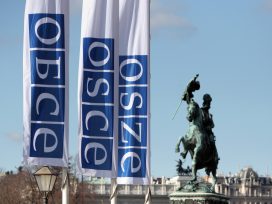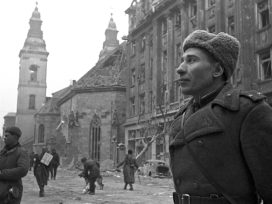On the battlefront of history
Memory, especially when traumatic, is often considered contentious rather than being recalled and honoured. Years of activism that went into uncovering the stories of victims of mass repression, memorialized and archived at Memorial, the NGO the Russian state recently forced into closure, now needs further rescuing.
In the clamour of war, the definitive act to shut down Memorial International on 28 February 2022 went under the radar. Two months earlier, the response to threatened closure had been very different: a section of Western media had decried the initial Russian Federation’s Supreme Court decision.1 Undoubtedly, the court’s position on the NGO’s appeal was well understood by February. Moreover, Russia’s launch of hostilities against Ukraine on 24 February 2022 had catapulted Europe into a new era, with new priorities and new crises. Europe has since ostracized Russia, the aggressor, and only a handful of Russian citizens dare oppose Putin’s regime and the war.
Memorial activists and supporters gathered outside the Supreme Court on the day of the appeal hearing, all wearing black masks on which the NGO’s famous rallying symbol, MY (we), had been replaced with MIR (peace). Today, the pre-eminent fight of all Memorialtsy and their supporters is to put an immediate end to Russian aggression against Ukraine. Vladimir Putin has theorized and justified his war on the pretext that a ‘fascist’ Ukraine was about to attempt genocide against Russians in the Donbas and that the time had come to ‘de-nazify’ Ukraine. Such falsification of history is monstrous and validates, a posteriori, the fight that Memorial has led for over three decades. Never before in Russia has history been so flagrantly manipulated to political ends, to construct a national narrative that allows no dissent and serves the geopolitical interests of a dictatorial regime to the point of justifying the unthinkable: aggression against Ukraine.
Memorial was shut down because it always pushed for a scientific approach to history, advocated the establishment of a national memory that would allow the country to confront the darkest chapters of its past, and resolutely opposed, from 2014 onward, Russia’s transparent annexation of Crimea and covert control of part of the Donbas.
Memorial’s remarkable work combined the study of Soviet history, including the traumatic dimension of ‘an ever-present past’, conservation of the memory of mass repressions and the defence of present-day human rights. A democratic society based on respect for human rights cannot be built without knowing, understanding and remembering the past.
Moreover, this past cannot be limited to the patriotic exaltation of a few ‘glorious episodes’ of Soviet history, such as the Great Patriotic War of 1941-45, a significantly revised and edited version of which tends to lead the charge. This has been the belief of Memorialtsy – women and men, of all ages and backgrounds, from Saint Petersburg to Vladivostok – who took part in this fight for history and against forgetting, and for a democratic Russia.
In this article, I will not discuss the substantial work of the Memorial Human Rights Centre but will concentrate instead on Memorial International, which focuses on history and memory.
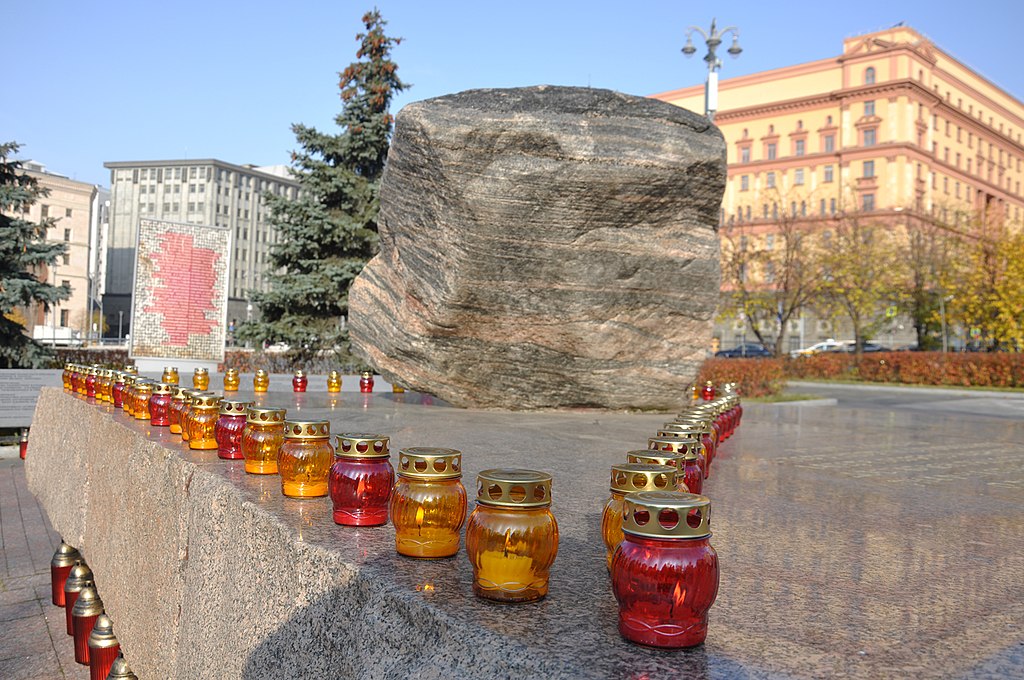
Return of the Names ceremony, Solovetsky Stone, Lubyanka Square, Moscow. Image via Wikimedia Commons
Remembering repressions
Over the last thirty years, Memorial International and its sixty or so regional branches became the principal centre for the study, research and documentation of the history and memory of mass repressions (primarily, yet not exclusively, in the Stalinist era). This activity took many forms: publishing research and volumes of documents; organizing conferences and symposiums; creating databases on the millions of victims of the repressions; collecting testimonies from survivors of Gulag camps; erecting hundreds of commemorative monuments and plaques at execution sites (mass graves from the Great Terror of 1937–38, discovered for the most part by Memorial activists) or internment sites (camps and prisons); preserving objects related to daily Gulag life in museum displays; organizing citizen initiatives (e.g., Return of Names, Topography of Terror and Last Address); and setting exam questions for high-school students related to the history of mass repressions.
From the beginning of the 1990s, historian colleagues at Memorial played a key role in enacting vital laws that enabled the substantial expansion of knowledge about the hidden face of Soviet history: the law of 18 October 1991 on ‘the rehabilitation of victims of political repression’; and that of 23 June 1992 on the ‘declassification of official documents that were at the origin of mass repressions’.
Memorial International historians revolutionized our knowledge of the Great Terror of 1937-38, that paroxysmal episode of Stalinist violence long presented, also in the West, as a series of political purges, more violent than preceding ones, primarily targeting communist elites. Bringing the then secret, now notorious, operational orders of the NKVD (the Interior Ministry of the Soviet Union) to light, Memorial’s historians showed that the Great Terror had been a vast and murderous programme of ‘social cleansing’, aimed at eliminating any ‘socially harmful elements’ from the ‘socialist’ society being built – in short, the biggest state-organized massacre perpetrated in Europe in peacetime.2
Historian colleagues at Memorial were also pioneers in the previously unexplored history of forced Soviet Union labour camps. I will limit myself here to citing a single, essential work: Ispravitel’no-trudovye lageri v SSSR, 1923-1960 (The Directory of Forced Labour Camps in the USSR, 1923-1960), edited by Arseny Roginsky and Nikita Okhotin, published in Moscow in 1998. This encyclopaedic work presented, for the first time, the ‘fact sheet’ of more than 600 concentration camps in the Gulag system. Precise data for each camp includes: its name and structure; detail of countless outbuildings; dates of operation; geographic location; economic activities; the changing number of detainees; the biographies of camp directors; and the location of camp archives.
Subsequently, between 2000 and 2010, collections of documents on the history of the Gulag and mass deportations were also published: from the first deportations of the kulaks (peasants in Russia wealthy enough to own a farm and hire labour) in the early 1930s to those of Polish and Baltic civilians from 1939-1941, and ‘punished peoples’ in the 1940s.3
Memorial historians also engaged with other taboo aspects of Soviet historiography: the fate of prisoners of war and Soviet civilians deported to Germany during the Second World War; the abuses of occupying Soviet forces in Germany at the end of the war; and the issue of dissidence in the 1960s, 1970s and 1980s.4
Over the years and through dozens of major Memorial-organized international symposiums between 2000 and 2010, the NGO became a formidable hub of discussion, debate and information for those studying Soviet history. Memorial’s headquarters in Moscow (whose future is today uncertain, now that the NGO has been shut down) houses Russia’s largest library of texts on the mass repressions (more than 40,000 volumes and 500 periodicals in some ten languages) and a collection, unique in the world, of private archives (more than 60,000 files) left to Memorial by families of victims.
Another of the main elements of Memorial’s work was the creation of an immense database detailing 3.5 million victims of political repression. Through this database, Memorial’s activists respond to the famous plaint of Russian poet Anna Akhmatova: ‘I’d like to name them all by name, But the list has been confiscated and is nowhere to be found.’5 Thanks to this database, hundreds of thousands of descendants of victims have finally been able to discover what happened to their disappeared family.6 It is accompanied by a sound archive, compiled since the end of the 1980s, comprising thousands of witness statements from the last Gulag camp survivors and deportees. In addition, there are collections of objects and clothing, and of drawings and paintings done by detainees shortly after their release from the camps or by deportees recently returned from exile; these are all kept in the Gulag History Museum housed in the NGO’s premises in Moscow. More than thirty exhibitions have been organized by Memorial based on these unique collections.7
Each of the NGO’s regional branches has its own database on victims of the repressions, its own publications, archives bequeathed by families of victims, recorded testimonies of escapees and internet site. A large part of the publications and archives, both in Memorial’s Moscow centre and its regional branches, have been digitalized; it should be possible to make copies and save them remotely.
The ‘memorialization’ of mass repressions had been a major part of the NGO’s work since the 1990s. Activists erected hundreds of modest memorials on detention facility, massacre and cemetery sites. Thousands of commemorative plaques were put up at the ‘last addresses’ of disappeared persons.8 Every year, on 29 October, the day before the Russian Day of Remembrance of the Victims of Political Repressions,9 the names of the victims were read out by a volunteer at a symbolic site such as in front of the Solovetsky Stone, erected in 1990 in Lubyanka Square, opposite the FSB, formerly KGB, headquarters in Moscow.
Attempts at falsification
The official, unifying, historical narrative attempts to glorify the history of the nation, whose most brilliant episode is considered the victory of the Soviet people in the Great Patriotic War. All Memorial initiatives significantly thwarted the extensive business of rewriting history that the regime began in 2010.
Since 2020, this new national narrative has been inscribed in the very text of Russia’s Constitution. It now includes this phrase: ‘The Russian Federation, the successor State of the USSR, protects the historical truth. . . , forbids the minimization of the importance of the heroism of the people in defending the Fatherland and exalts the sacred character of the USSR’s victory in the Great Patriotic War.’10 However, the official narrative doesn’t entirely efface dark chapters of the Soviet past: the re-opening of the expanded Gulag History Museum on a new site in Moscow in 2015 and the Wall of Sorrow erected in memory of the victims of repression in 2017 being two examples.11
Nevertheless, the state seeks to frame and control all discourse and initiatives coming from Russian civil society. Crimes of the past are cut loose from reality: no information about the identity of those responsible is available12 and no judicial enquiry has been opened to discover those responsible. Victims, too, are cut loose: no action is taken to identify them, to help families find the bodies of their relatives, nor to offer reparations, whether symbolic or material, to survivors. As a result, the mass crimes of the Soviet regime appear as a sort of natural catastrophe for which no one, and especially not the state, bears responsibility. Given that these crimes were committed or approved by the country’s most senior leadership, recognizing them and identifying the culprits would mean condemning the entire Soviet regime and shaking the very foundations of the current regime, which presents itself as the ‘successor of the USSR’ and whose president is a former KGB officer.
The attacks against Memorial escalated significantly when the NGO began publishing not only the lists of victims of mass repression but also the names of NKVD officials implicated in the mass arrests, torture and executions. The organization was already a target: since the enactment of the 2012 law on ‘foreign agents’, which applies to Russian NGOs receiving funding from outside Russia,13 the authorities had been piling on the pressure: perquisitions, repeated audits, smear campaigns in the media, astronomical fines for ‘failing to display the foreign agent label’, and threats against its members.
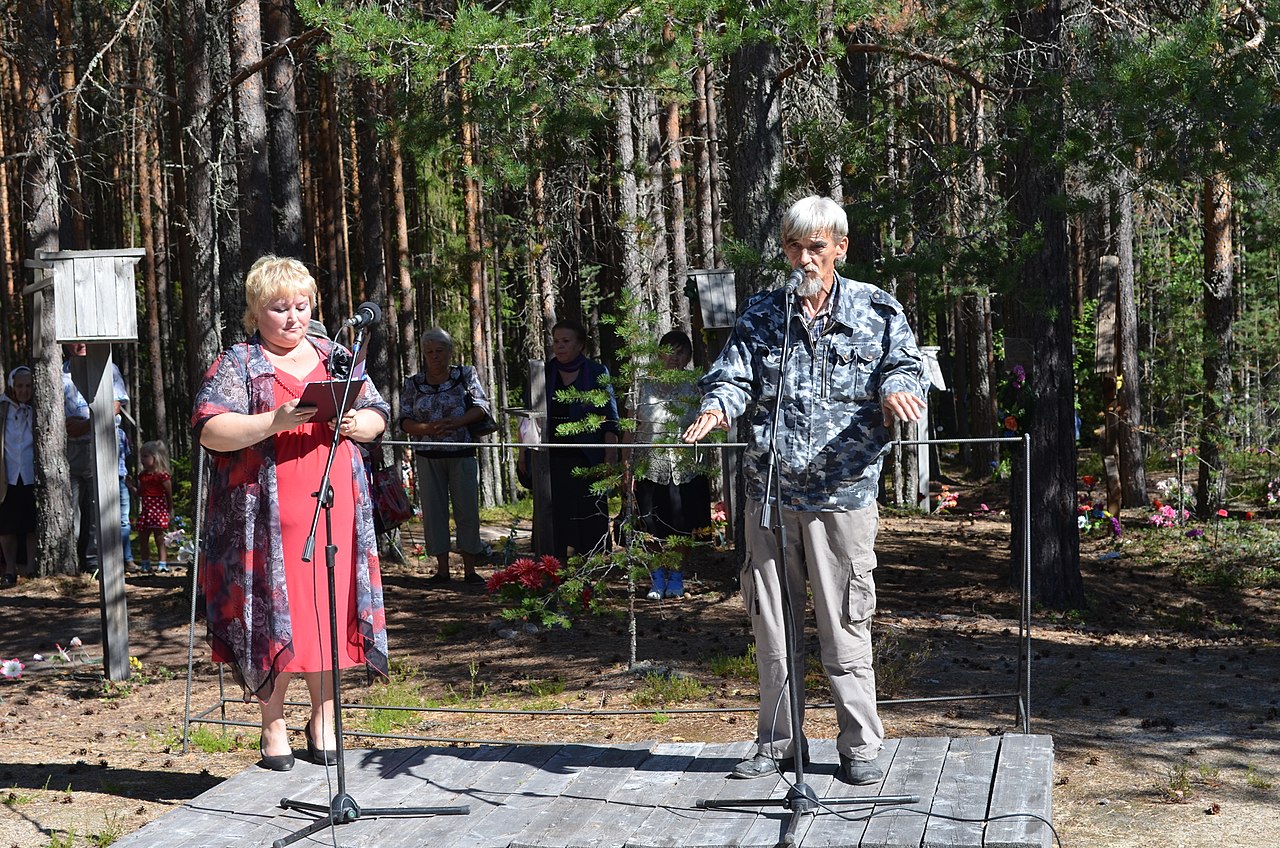
Yury Dmitriev, Sandarmokh. Image via Wikimedia Commons
However, a new line was clearly crossed in 2016 when several Memorialtsy, historians from the organization, were arrested for having published lists of NKVD agents. The most emblematic case was that of Yury Dmitriev, the head of the NGO’s Karelia branch, who in 1997 discovered the Sandormokh mass grave in Karelia, where more than 9,000 people convicted during the Great Terror of 1937–38 had been executed in utmost secrecy.14 Dmitriev had also compiled numerous Books of Memory dedicated to the victims of repressions in Karelia and authored various articles revealing the identity of those responsible. The state prosecutor brought far-fetched and defamatory charges of pedophilia against him, leading to his arrest in 2016. He was subsequently released in 2018 – an exceptional occurrence in the annals of Russian jurisprudence – but remained in pre-trial detention until 27 December 2021, when he was sentenced on appeal to fifteen years in a high-security prison colony15
We could also cite the case of Sergei Koltyrin, a historian, director of the Medvezhyegorsk museum in Karelia, and member of Memorial. In 2018 he was sentenced to nine years in prison, also on charges of pedophilia, after having spoken out against two historians from the official Russian Military Historical Society. He declared their hypothesis that bodies found in Sandormokh mass graves were those of Soviet prisoners of war executed by the Finns in 1941 ‘absurd’.16
This Russian Military Historical Society – flanked by a history commission established to ‘counter attempts to falsify history to the detriment of Russia’s interests’ and directly linked to President Putin – has led the charge against any deviation from the official narrative on the ‘battlefront of history’. Headed by Vladimir Medinsky, Minister of Culture from 2010 to 2020,17 the society has recently encouraged Tver authorities to remove the commemorative plaques to victims of Stalinist repression that Memorial placed on the walls of the city’s prison, where many people had been tortured and executed between 1937 and 1941.
A few months ago, the same society caused a stir when it denied that the USSR bore any responsibility for the massacre of the Polish elite at Katyn in April 1940, even though Boris Yeltsin had officially recognized the fact in the early 1990s. ‘The so-called historical consensus around Katyn is part of a more general propaganda campaign aimed at making the USSR take responsibility for the outbreak of the Second World War,’ declared one of the society’s representatives.
A pretext for war
The regime has added key elements about the Great Patriotic War to the Constitution in a bid to legitimize its new national narrative. It has also enacted a series of memory laws, the most notorious of which is article 354.1 of the penal code of the Russian Federation, which criminalizes the ‘denial or the rehabilitation of Nazism’. On the surface, the clauses of this article resemble the memory laws adopted in other democratic countries, but in reality their scope is far wider, since they also criminalize the ‘dissemination of false information on the activities of the Soviet Union during the Second World War’, ‘the dissemination of information that casts in a negative light the glorious military history of Russia’, and ‘the denigration of those who fought in the Great Patriotic War’.
Moreover, the last memory law enacted by the Duma at the start of 2022 prohibits ‘any public attempt to interpret the aims and actions of the Soviet Union and Nazi Germany during the Second World War’. Two days before the invasion of Ukraine, the Duma toughened the potential penalty for anyone contravening these laws to a maximum of one year in prison.18
Since the enactment of these memory laws, hundreds of people have been charged and sentenced. Examples of blog entries include statements that: ‘Soviet communist leaders actively collaborated with Nazi Germany to divide up Europe in accordance with the secret protocol of the Molotov-Ribbentrop pact’; ‘the USSR and Germany jointly attacked Poland, the Second World War began in September 1939 and not in June 1941’; mention the ‘crimes committed by the Red Army against the German civilian population in 1945’. Others simply remind readers that General Rudenko, the Soviet Union’s chief prosecutor in the Nuremburg trials, had also sat on the extraordinary courts during the years of the Great Terror, from 1937 to 1938, and, as such, could be considered the executioner of thousands of innocent victims. A whole series of other measures – such as the refusal to declassify sensitive archives, and allowing a thesis to be defended or accepted if it contains themes ‘tarnishing the honour of the Russian people’19 – impede research on several subjects. Information on Soviet collaboration with Nazi occupiers, the staff and hierarchy of organizations involved in repression, and foreign activities of the secret services as a core element of Soviet diplomacy, for example, are taboo.
For many years now, another issue, related to the central preoccupation with the Great Patriotic War, ‘the historical centrepiece of Putin’s regime’,20 has been keeping both the Russian Military Historical Society and the Russian media busy: the Ukrainian ‘neo-Nazi’ movement. While any attempt to recognize that Russian or Belarusian people collaborated or even adapted to life with Nazi occupiers is stubbornly rejected and subject to prosecution, Russian propaganda heavily targets Ukrainian nationalist movements (the Organization of Ukrainian Nationalists and the Ukrainian Insurgent Army).
In the chaos of the war and double occupation – first by the Soviets (September 1939-June 1941), then by the Germans (June 1941-summer of 1944) – these movements unsuccessfully tried to create an autonomous Ukrainian state, and subsequently offered determined resistance to the re-Sovietization of western Ukraine in the post-war years, until the end of the 1940s. According to the Soviet state security forces, no less than half a million Ukrainians were killed in guerrilla warfare led by the partisans of the Ukrainian Insurgent Army or deported to the Gulag camps between 1944 and 1948.
Yet it is this same nationalist movement from western Ukraine, active between 1930 and 1940, that Russian propaganda today brandishes as a bogeyman. The influence of this supposedly fascist or neo-Nazi nationalism is negligible in Ukrainian political life and society. Its influence is infinitely less than that of the German, Dutch, Flemish, Italian, or French extreme right parties.21
Yet if we are to believe Russian media, Ukrainian-speaking Ukrainians, for years labelled Ukr-fascisty (Ukrainian fascists), are contaminated by this so-called neo-Nazi virus and ready to lead a genocide against Ukraine’s Russian minority. This monstrous falsification of history, whose discovery has recently stupefied global public opinion is the work of years of steady preparation. Memorial was its first victim. Today, the Ukrainian people are paying in blood for these crude falsifications, which serve as a pretext for the criminal aggression of Vladimir Putin’s dictatorial regime against an independent and democratic Ukraine.

This text is published in cooperation with CAIRN International Edition. Translation and initial edit by Cadenza Academic Translations.
See, for example, the front page of Le Monde from 29 December 2021.
800,000 people were shot and 1.5 million people sentenced to long periods of Gulag forced labour during the Great Terror. See: Arseny Roginsky, Nikita Okhotin, Nikita Petrov, Alexandre Daniel, Alexandre Gourianov, Oleg Leibovitch and Mikhail Rogatchev.
Istoriâ Stalinskogo Gulaga (History of the Stalinist Gulag), Vol. 7, Moscow, Rosspen, 2004. Also see: work of Memorial historians, including Sergey Krasilnikov on the farmers deported to Western Siberia, Mikhail Rogatchev on those deported to the Komi Republic and Alexei Babii on deportations to Western Siberia.
See: Acta Samizdatica, a collection of sources and documents on the clandestine press in the USSR between 1960 and 1980, co-edited by Memorial and the Moscow Historical Library.
Anna Akhmatova, ‘Requiem’, 1940, trans. Robin Kemball. In: Selected Poems, ed. Walter Arndt, Ann Arbor, Michigan, Ardis, 1976.
The database is duplicated in each region in the Knigi pamiati (Books of Memory), edited by regional Memorial branches.
Remarkable shows from 2021 included one on women in the Gulag and another entitled Bromberg’s Violin after the Jewish violinist, a member of the Zionist movement, who was sent to the Gulag, which reveals the workings of Stalinist antisemitism. It is worth noting that Memorial lent a significant part of its collection for exhibitions on the Gulag in Geneva (Musée d’ethnographie, 2004-5), Liège (Cité Miroir, 2020), Grenoble (Musée de la Résistance, 2019) and Limoges (Musée de la Résistance, 2021).
These two ‘citizen actions’ organized by Memorial are known respectively as the ‘Topography of Terror’ and ‘Last Address’.
This day was inaugurated by political prisoners themselves at the end of the 1980s and recognized by the authorities at the start of the 1990s.
Translator’s note: Unless otherwise stated, all translations of cited foreign language material in this article are our own.
Unlike the Solovetsky Stone, erected in 1991 by Memorial in Lubyanka Square in Moscow, opposite the KGB/FSB headquarters, the ‘Wall of Sorrow’, an official monument, was erected on an insignificant site in the capital, far from the headquarters of the Soviet-era security services.
The limitation period on the files of state security agents has recently been extended by thirty years.
Those that receive foreign funding are obliged to register as ‘an organization operating as a foreign agent’ and to display this label, with its disgraceful connotations, on all their publications, at public speaking events and demonstrations, and on their correspondence.
See Irina Flige, Sandormokh. Le livre noir d’un lieu de mémoire, trans. Nicolas Werth (Paris: Les Belles Lettres, 2021)
For the full dossier on the Dmitriev affair, see the Mémorial France website: memorial-france.org.
Sergei Koltyrin died in prison in April 2020. For more information on the attempt to ‘revise’ the Sandormokh site, see: Nicolas Werth and Irina Frige, ‘Sandarmokh, un charnier de la Grande Terreur’, L’Histoire, No. 470, April 2020.
One of Putin’s most faithful supporters, Medinsky was promoted from minister of culture to head of the Russian delegation charged with ‘negotiating’ the conditions of a ceasefire with the Ukrainian delegation.
See: Francine Hirsch, ‘Putin’s Memory Laws Set the Stage for His War in Ukraine’, Lawfare, 28 February 2022, https://www.lawfareblog.com/putins-memory-laws-set-stage-his-war-ukraine.
See, for example, the 2017 decision to invalidate the doctoral title awarded to Kirill Alexandrov for his thesis on the Vlassov army (University of Saint-Petersburg).
As Alexander Guryanov, head of the Memorial Human Rights Centre, astutely put it.
Its ‘electoral weight’ is currently estimated at 5-6% of votes.
Published 27 June 2022
Original in French
Translated by
Cadenza Academic Translations
First published by Esprit 4/2022 (French version); Eurozine (English version)
Contributed by Esprit © Nicolas Werth, Esprit / Eurozine
PDF/PRINTPublished in
In collaboration with
Newsletter
Subscribe to know what’s worth thinking about.
Related Articles
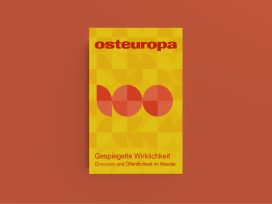
In the spirit of the times and against the grain
Osteuropa 1–3/2025
Osteuropa at 100: Manfred Sapper on the history of the journal from Weimar to the present; Gerd Koenen on a century of German–Russian projections; Katharina Raabe on eastern European literature in translation; Dorothea Redepenning on the bilateral politics of classical.
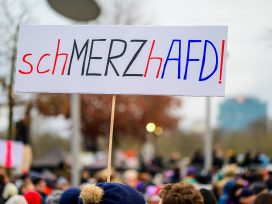
After the catastrophic performance of the traffic light coalition, what Germany needs is a strong, unified government able to provide an antidote to the new fascism. Friedrich Merz must begin by rebuilding trust, writes the editor of ‘Blätter für deutsche und internationale Politik’.




